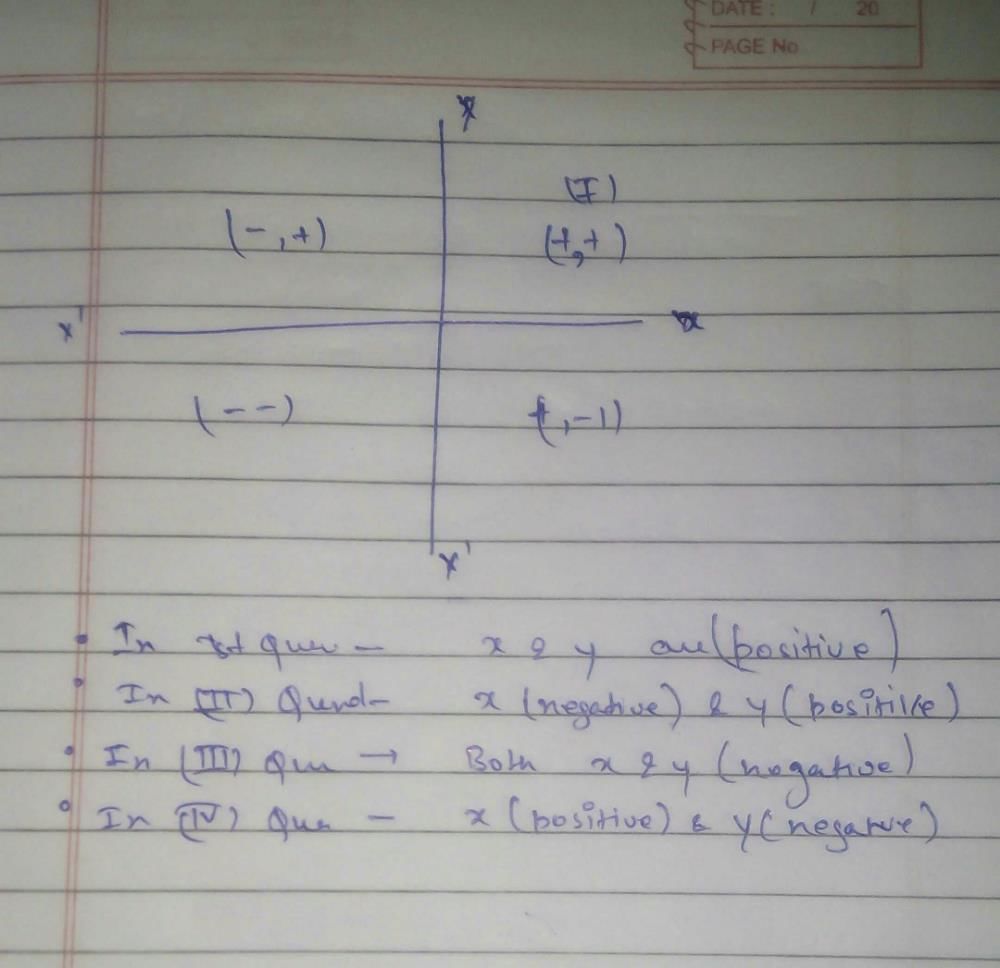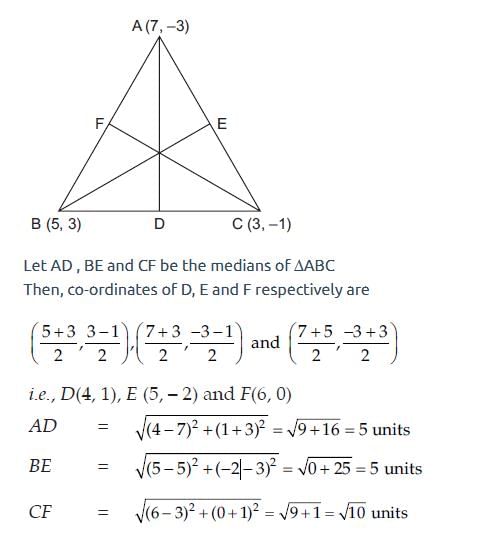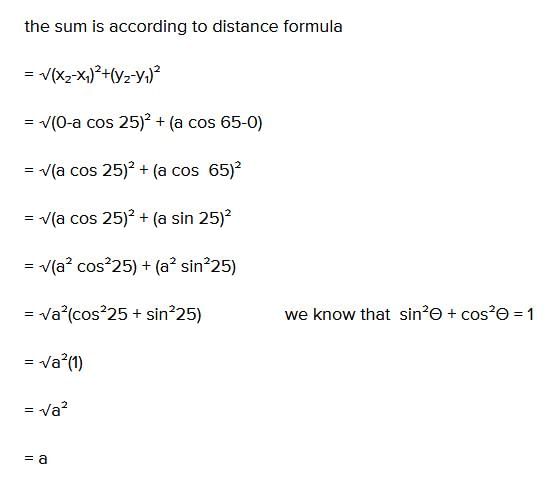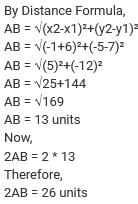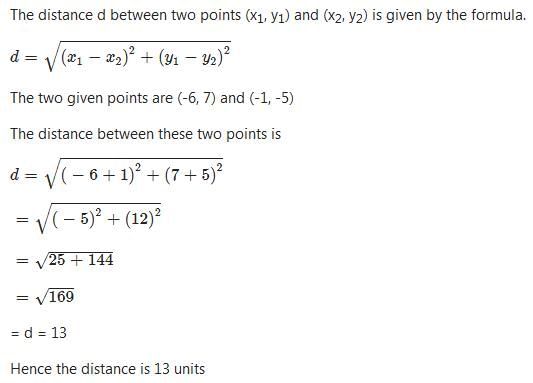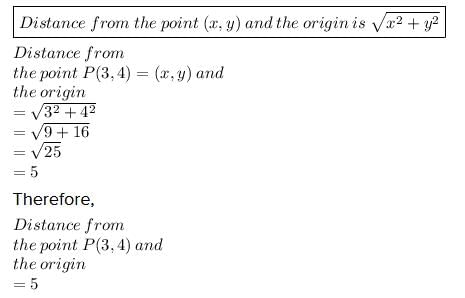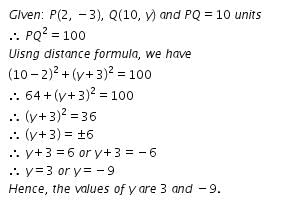All Exams >
Interview Preparation >
Quantitative Aptitude (Quant) >
All Questions
All questions of Coordinate Geometry for Interview Preparation Exam
The points A(0, 6), B(-5, 3) and C(3, 1) are the vertices of a triangle which is ? - a)equilateral
- b)right angled
- c)isosceles
- d)scalene
Correct answer is option 'C'. Can you explain this answer?
The points A(0, 6), B(-5, 3) and C(3, 1) are the vertices of a triangle which is ?
a)
equilateral
b)
right angled
c)
isosceles
d)
scalene

|
Quantronics answered |
AB2= (-5 - 0)2 + (-3 - 0)2 = 25 + 9 = 34
BC2 = (3 + 5)2 + (1-3)2 = 82 + (-2)2 = 64 + 4 = 68
AC2 = (3 - 0)2 + (1 - 6)2 = 9 + 25 = 34.
AB = AC. ==> ΔABC is isosceles.
BC2 = (3 + 5)2 + (1-3)2 = 82 + (-2)2 = 64 + 4 = 68
AC2 = (3 - 0)2 + (1 - 6)2 = 9 + 25 = 34.
AB = AC. ==> ΔABC is isosceles.
If the co – ordinates of a point are (3, – 7), then its ordinate is- a)– 7
- b)3
- c)– 3
- d)7
Correct answer is option 'A'. Can you explain this answer?
If the co – ordinates of a point are (3, – 7), then its ordinate is
a)
– 7
b)
3
c)
– 3
d)
7

|
KS Coaching Center answered |
Explanation:
Since y−coordinate of a point is called ordinate.its distance from the x-axis measured parralel to the y - axisTherefore, ordinate is −7.
In which quadrant does the point(1, 5) lie? - a)1st
- b)2nd
- c)3rd
- d)4th
Correct answer is option 'A'. Can you explain this answer?
In which quadrant does the point(1, 5) lie?
a)
1st
b)
2nd
c)
3rd
d)
4th

|
Rahul Rn answered |
A quadrant because all value postive in first quadrant.
If (a, 0) , (0, b) and (x, y) are collinear, then- a)ay – bx = 1
- b)ay + bx = ab
- c)ax – by = ab
- d)ax + by = 1
Correct answer is option 'B'. Can you explain this answer?
If (a, 0) , (0, b) and (x, y) are collinear, then
a)
ay – bx = 1
b)
ay + bx = ab
c)
ax – by = ab
d)
ax + by = 1

|
Naroj Boda answered |
Explanation:
If given points are collinear, the area of triangle formed by these three points is 0.
Distance between two points :If (x1, y1) and B(x2, y2) be two points, then AB = √(x2 - x1)2 + (y2 - y1)2Find the distance between the points A(-4, 7) and B(2, -5). - a)8√5 Units
- b)6√5 Units
- c)6√4 Units
- d)None of these
Correct answer is option 'B'. Can you explain this answer?
Distance between two points :
If (x1, y1) and B(x2, y2) be two points, then AB = √(x2 - x1)2 + (y2 - y1)2
Find the distance between the points A(-4, 7) and B(2, -5).
a)
8√5 Units
b)
6√5 Units
c)
6√4 Units
d)
None of these
|
|
Aisha Gupta answered |
AB = √(2+4)2 + (-5-7)2
= √62 + (-12)2
= √36+144 = √180
=√36*5 = 6√5 units.
= √62 + (-12)2
= √36+144 = √180
=√36*5 = 6√5 units.
The point where the perpendicular bisector of the line segment joining the points A(2, 5) and B(4, 7) cuts is:- a)(0, 0)
- b)(3, 6)
- c)(6, 3)
- d)(2, 5)
Correct answer is option 'B'. Can you explain this answer?
The point where the perpendicular bisector of the line segment joining the points A(2, 5) and B(4, 7) cuts is:
a)
(0, 0)
b)
(3, 6)
c)
(6, 3)
d)
(2, 5)

|
Divey Sethi answered |
Explanation:
Since, the point, where the perpendicular bisector of a line segment joining the points A(2 , 5) and B(4 , 7) cuts, is the mid-point of that line segment.
Area of a triangle : If A(x1,y1), B(x2,y2 and C(x3, y3) be three vertices of a ΔABC, then its area is given by:Δ = 1/2 [x1(y2 - y3 + x2(y3 - y1) + x3(y1 - y2)]Find the area of ΔABC whose vertices are A(9, -5), B(3, 7) and (-2, 4). - a)29 units
- b)35.9 sq.units
- c)39 sq.units
- d) 39.5 sq.units
Correct answer is option 'C'. Can you explain this answer?
Area of a triangle :
If A(x1,y1), B(x2,y2 and C(x3, y3) be three vertices of a ΔABC, then its area is given by:
Δ = 1/2 [x1(y2 - y3 + x2(y3 - y1) + x3(y1 - y2)]
Find the area of ΔABC whose vertices are A(9, -5), B(3, 7) and (-2, 4).
a)
29 units
b)
35.9 sq.units
c)
39 sq.units
d)
39.5 sq.units
|
|
Raja Gopal answered |
Area=1/2[9(3)+3(9)+(-2)(-12)]
=1/2[27+27+24]
=1/2[78]
=39 sq.units
Area=39 sq.units
=1/2[27+27+24]
=1/2[78]
=39 sq.units
Area=39 sq.units
If the distance between the points (p, – 5) and (2, 7) is 13 units, then the value of ‘p’ is- a)– 3, 7
- b)3, – 7
- c)– 3, – 7
- d)3, 7
Correct answer is option 'A'. Can you explain this answer?
If the distance between the points (p, – 5) and (2, 7) is 13 units, then the value of ‘p’ is
a)
– 3, 7
b)
3, – 7
c)
– 3, – 7
d)
3, 7
|
|
Ravi Singh answered |
Explanation:
Let point A be (p,−5) and point B (2, 7) and distance between A and B = 13 units
The points A(-4, 0), B(1, -4), and C(5, 1) are the vertices of - a)An isosceles right angled triangle
- b)An equilateral triangle
- c)A scalene triangle
- d)None of these
Correct answer is option 'A'. Can you explain this answer?
The points A(-4, 0), B(1, -4), and C(5, 1) are the vertices of
a)
An isosceles right angled triangle
b)
An equilateral triangle
c)
A scalene triangle
d)
None of these
|
|
Ravi Singh answered |
AB2 = (1 + 4)2 + (-4 - 0)2
= 25 + 16 = 41,
BC2 = (5 - 1)2 + (1 + 4)2 = 42 + 52
= 16 + 25 = 41
AC2 = (5 + 4)2 + (1 - 0)2
= 81 + 1 = 82
AB = BC and AB2 = BC2 = AC2
ΔABC is an isosceles right angled triangle
= 25 + 16 = 41,
BC2 = (5 - 1)2 + (1 + 4)2 = 42 + 52
= 16 + 25 = 41
AC2 = (5 + 4)2 + (1 - 0)2
= 81 + 1 = 82
AB = BC and AB2 = BC2 = AC2
ΔABC is an isosceles right angled triangle
If the points (2, 3), (4, k) and (6, – 3) are collinear, then the value of ‘k’ is- a)1
- b)0
- c)3
- d)4
Correct answer is option 'B'. Can you explain this answer?
If the points (2, 3), (4, k) and (6, – 3) are collinear, then the value of ‘k’ is
a)
1
b)
0
c)
3
d)
4

|
Anshul Kulkarni answered |
Explanation:
Let the points A (2, 3), B(4,k) and C(6,−3) be collinear.
If the points are collinear then area of triangle ABC formed by these three points is 0.
If the points are collinear then area of triangle ABC formed by these three points is 0.
The base of an equilateral triangle ABC lies on the y – axis. The co – ordinates of the point C is (0, – 3). If origin is the midpoint of BC, then the co – ordinates of B are- a)(0, 3)
- b)(3, 0)
- c)( – 3, 0)
- d)(0, – 3)
Correct answer is option 'A'. Can you explain this answer?
The base of an equilateral triangle ABC lies on the y – axis. The co – ordinates of the point C is (0, – 3). If origin is the midpoint of BC, then the co – ordinates of B are
a)
(0, 3)
b)
(3, 0)
c)
( – 3, 0)
d)
(0, – 3)

|
Bank Exams India answered |
Explanation:
Let the coordinate of B be (0,a).
It is given that (0, 0) is the mid-point of BC.
It is given that (0, 0) is the mid-point of BC.
Therefore 0 = (0 + 0) /2 , 0 =(a - 3) /2 a - 3 = 0 , a = 3
Therefore, the coordinates of B are (0, 3).
The abscissa of any point on the x – axis is- a)– 1
- b)0
- c)x
- d)1
Correct answer is option 'C'. Can you explain this answer?
The abscissa of any point on the x – axis is
a)
– 1
b)
0
c)
x
d)
1

|
Shail Jain answered |
Explanation:Since coordinates of any point on x−axis is (x,0).Therefore, abscissa is x.
Find the coordinates of the point equidistant from the points A(1, 2), B (3, –4) and C(5, –6).- a)(2, 3)
- b)(11,2)
- c)(0, 3)
- d) (1, 3)
Correct answer is option 'B'. Can you explain this answer?
Find the coordinates of the point equidistant from the points A(1, 2), B (3, –4) and C(5, –6).
a)
(2, 3)
b)
(11,2)
c)
(0, 3)
d)
(1, 3)
|
|
Ravi Singh answered |
Given three points A(1,2) B(3,-4) and C(5,-6)
we have to find the coordinates of the point equidistant from the points.
The point that is equidistant from three points is called circumcenter which can be evaluated to find the perpendicular bisectors.
To find the perpendicular bisectors of AB:
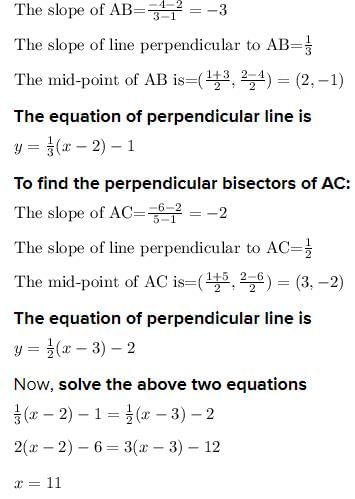

 (11,2)
(11,2)


 (11,2)
(11,2)The distance of the point ( – 5, 12) from the y – axis is- a)5 units
- b)12 units
- c)- 5 units
- d)13 units
Correct answer is option 'A'. Can you explain this answer?
The distance of the point ( – 5, 12) from the y – axis is
a)
5 units
b)
12 units
c)
- 5 units
d)
13 units
|
|
Aarav Sharma answered |
Explanation:
To find the distance of a point from the y-axis, we need to measure the perpendicular distance from the point to the y-axis.
Given: Point (5, 12)
Steps to find the distance:
Step 1: Identify the coordinates of the point.
The given point is (5, 12), where 5 represents the x-coordinate and 12 represents the y-coordinate.
Step 2: Draw a line perpendicular to the y-axis passing through the point.
We draw a line from the point (5, 12) perpendicular to the y-axis. Let's call the point where the line intersects the y-axis as P.
Step 3: Measure the distance between the point and the y-axis.
The distance between the point (5, 12) and the y-axis is the length of the line segment formed by the point and point P on the y-axis.
Step 4: Calculate the distance using the Pythagorean theorem.
The distance can be calculated using the Pythagorean theorem, which states that in a right-angled triangle, the square of the hypotenuse is equal to the sum of the squares of the other two sides.
In this case, the distance is the length of the line segment, which is the hypotenuse of a right-angled triangle. The other two sides are the x-coordinate (5) and the y-coordinate (12).
Using the Pythagorean theorem, we can calculate the distance as follows:
Distance = √((5)^2 + (12)^2)
= √(25 + 144)
= √169
= 13
Therefore, the distance of the point (5, 12) from the y-axis is 13 units.
Since none of the given options match the correct answer, it seems there is an error in the options provided. The correct answer should be option 'D' (13 units) instead of option 'A' (5 units).
To find the distance of a point from the y-axis, we need to measure the perpendicular distance from the point to the y-axis.
Given: Point (5, 12)
Steps to find the distance:
Step 1: Identify the coordinates of the point.
The given point is (5, 12), where 5 represents the x-coordinate and 12 represents the y-coordinate.
Step 2: Draw a line perpendicular to the y-axis passing through the point.
We draw a line from the point (5, 12) perpendicular to the y-axis. Let's call the point where the line intersects the y-axis as P.
Step 3: Measure the distance between the point and the y-axis.
The distance between the point (5, 12) and the y-axis is the length of the line segment formed by the point and point P on the y-axis.
Step 4: Calculate the distance using the Pythagorean theorem.
The distance can be calculated using the Pythagorean theorem, which states that in a right-angled triangle, the square of the hypotenuse is equal to the sum of the squares of the other two sides.
In this case, the distance is the length of the line segment, which is the hypotenuse of a right-angled triangle. The other two sides are the x-coordinate (5) and the y-coordinate (12).
Using the Pythagorean theorem, we can calculate the distance as follows:
Distance = √((5)^2 + (12)^2)
= √(25 + 144)
= √169
= 13
Therefore, the distance of the point (5, 12) from the y-axis is 13 units.
Since none of the given options match the correct answer, it seems there is an error in the options provided. The correct answer should be option 'D' (13 units) instead of option 'A' (5 units).
If the vertices of a triangle are (1, 1), ( – 2, 7) and (3, – 3), then its area is- a)2 sq. units
- b)24 sq. units
- c)0 sq. units
- d)12 sq. units
Correct answer is option 'C'. Can you explain this answer?
If the vertices of a triangle are (1, 1), ( – 2, 7) and (3, – 3), then its area is
a)
2 sq. units
b)
24 sq. units
c)
0 sq. units
d)
12 sq. units
|
|
Aarav Sharma answered |
To find the area of a triangle, we can use the formula for the area of a triangle given its vertices.
The formula for the area of a triangle with vertices (x1, y1), (x2, y2), and (x3, y3) is:
Area = 0.5 * |(x1*(y2-y3) + x2*(y3-y1) + x3*(y1-y2))|
Let's calculate the area of the given triangle using this formula.
Given vertices are:
A(1, 1)
B(2, 7)
C(3, 3)
Calculating the area using the formula:
Area = 0.5 * |(1*(7-3) + 2*(3-1) + 3*(1-7))|
= 0.5 * |(1*4 + 2*2 + 3*(-6))|
= 0.5 * |(4 + 4 - 18)|
= 0.5 * |-10|
= 0.5 * 10
= 5
Therefore, the area of the given triangle is 5 square units.
Now let's look at the given options:
a) 2 sq. units
b) 24 sq. units
c) 0 sq. units
d) 12 sq. units
Option c) 0 sq. units is the correct answer because the calculated area of the triangle is not equal to any of the given options. The triangle does have a non-zero area, so options a), b), and d) can be eliminated.
Hence, the correct answer is option c) 0 sq. units.
The formula for the area of a triangle with vertices (x1, y1), (x2, y2), and (x3, y3) is:
Area = 0.5 * |(x1*(y2-y3) + x2*(y3-y1) + x3*(y1-y2))|
Let's calculate the area of the given triangle using this formula.
Given vertices are:
A(1, 1)
B(2, 7)
C(3, 3)
Calculating the area using the formula:
Area = 0.5 * |(1*(7-3) + 2*(3-1) + 3*(1-7))|
= 0.5 * |(1*4 + 2*2 + 3*(-6))|
= 0.5 * |(4 + 4 - 18)|
= 0.5 * |-10|
= 0.5 * 10
= 5
Therefore, the area of the given triangle is 5 square units.
Now let's look at the given options:
a) 2 sq. units
b) 24 sq. units
c) 0 sq. units
d) 12 sq. units
Option c) 0 sq. units is the correct answer because the calculated area of the triangle is not equal to any of the given options. The triangle does have a non-zero area, so options a), b), and d) can be eliminated.
Hence, the correct answer is option c) 0 sq. units.
If the end points of a diameter of a circle are ( – 4, – 3) and (2, 7), then the co – ordinates of the centre are- a)( – 1, 2)
- b)(2, – 1)
- c)(0, 0)
- d)none of these
Correct answer is option 'A'. Can you explain this answer?
If the end points of a diameter of a circle are ( – 4, – 3) and (2, 7), then the co – ordinates of the centre are
a)
( – 1, 2)
b)
(2, – 1)
c)
(0, 0)
d)
none of these

|
Shail Jain answered |
Explanation:
Let the coordinates of centre O be (x,y). The end points of diameter of the circle are A (- 4, - 3) and B(2, 7).
Since centre is the midpoint of diameter.
Therefore, the coordinates of the centre O is (−1,2).
Distance of a point from the origin:The distance of a point A(x, y) from the origin O(0, 0) is given by OA = √x2 + y2Find the distance of the point A(4, -2) from the origin. - a)4√5 units
- b)2√5 units
- c)5√2 units
- d)7√2 units
Correct answer is option 'B'. Can you explain this answer?
Distance of a point from the origin:
The distance of a point A(x, y) from the origin O(0, 0) is given by OA = √x2 + y2
Find the distance of the point A(4, -2) from the origin.
a)
4√5 units
b)
2√5 units
c)
5√2 units
d)
7√2 units
|
|
Rhea Reddy answered |
OA = √4 - 02+(-2 - 0)2 = √16+4 = √20 = radic;4*5 = 2√5 units
If the co – ordinates of a point are ( – 5, 11), then its abscissa is- a)– 11
- b)5
- c)– 5
- d)11
Correct answer is option 'C'. Can you explain this answer?
If the co – ordinates of a point are ( – 5, 11), then its abscissa is
a)
– 11
b)
5
c)
– 5
d)
11
|
|
Aarav Sharma answered |
Explanation:
In mathematics, the coordinates of a point in a two-dimensional plane are represented by two numbers called the abscissa (x-coordinate) and the ordinate (y-coordinate). The abscissa represents the horizontal position of the point, while the ordinate represents the vertical position.
Given that the coordinates of the point are (5, 11), we can determine the abscissa by looking at the first number in the pair, which is 5.
So, the abscissa of the point is 5.
Key Points:
- The abscissa of a point represents its horizontal position in the coordinate plane.
- The abscissa is determined by the first number in the pair of coordinates.
- In this case, the abscissa of the point with coordinates (5, 11) is 5.
Therefore, the correct answer is option C) 5.
In mathematics, the coordinates of a point in a two-dimensional plane are represented by two numbers called the abscissa (x-coordinate) and the ordinate (y-coordinate). The abscissa represents the horizontal position of the point, while the ordinate represents the vertical position.
Given that the coordinates of the point are (5, 11), we can determine the abscissa by looking at the first number in the pair, which is 5.
So, the abscissa of the point is 5.
Key Points:
- The abscissa of a point represents its horizontal position in the coordinate plane.
- The abscissa is determined by the first number in the pair of coordinates.
- In this case, the abscissa of the point with coordinates (5, 11) is 5.
Therefore, the correct answer is option C) 5.
In which quadrant does the point(9, -2) lie?- a)1st
- b)2nd
- c)3rd
- d)4th
Correct answer is option 'D'. Can you explain this answer?
In which quadrant does the point(9, -2) lie?
a)
1st
b)
2nd
c)
3rd
d)
4th
|
|
Aisha Gupta answered |
The point (9, -2) lies in 4th quadrant.
The point ( – 3, 5) lies in the ___________ quadrant- a)III
- b)II
- c)I
- d)IV
Correct answer is option 'B'. Can you explain this answer?
The point ( – 3, 5) lies in the ___________ quadrant
a)
III
b)
II
c)
I
d)
IV
|
|
Aisha Gupta answered |
In point (-3, 5), x-coordinate is negative and y-coordinate is positive. So, the point lies in the second quadrant.
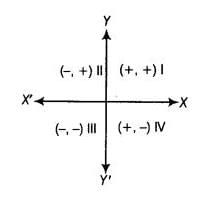

If the mid – point of the line segment joining the points (a, b – 2) and ( – 2, 4) is (2, – 3), then the values of ‘a’ and ‘b’ are- a)6, 8
- b)4, – 5
- c)6, – 8
- d)– 6, 8
Correct answer is option 'C'. Can you explain this answer?
If the mid – point of the line segment joining the points (a, b – 2) and ( – 2, 4) is (2, – 3), then the values of ‘a’ and ‘b’ are
a)
6, 8
b)
4, – 5
c)
6, – 8
d)
– 6, 8

|
Rajeev Rane answered |
Explanation:
Let the coordinates of midpoint O(2,−3) is equidistance from the points A(a,b−2) and B(−2,4).
The distance between the points A(5, -7) and B(2, 3) is:- a) 109
- b)5√7
- c)√109
- d)None of these
Correct answer is option 'C'. Can you explain this answer?
The distance between the points A(5, -7) and B(2, 3) is:
a)
109
b)
5√7
c)
√109
d)
None of these

|
Bank Exams India answered |
AB2 = (2 - 5)2 + (3 + 7)2
=> (-3)2 + (10)2
=> 9 + 100 => √109
=> (-3)2 + (10)2
=> 9 + 100 => √109
Find the distance of the point A(3, -3) from the origin. - a)3√2
- b)3√6
- c) 6√2
- d)7√2
Correct answer is option 'A'. Can you explain this answer?
Find the distance of the point A(3, -3) from the origin.
a)
3√2
b)
3√6
c)
6√2
d)
7√2
|
|
Nikita Singh answered |
OA = √32+(-3)2 = √9+9 = √18 = 3√2
The distance of a point from the y – axis is called- a)none of these
- b)abscissa
- c)ordinate
- d)origin
Correct answer is option 'B'. Can you explain this answer?
The distance of a point from the y – axis is called
a)
none of these
b)
abscissa
c)
ordinate
d)
origin
|
|
Aarav Sharma answered |
Definition of Abscissa:
The abscissa of a point is the distance of the point from the y-axis. It is the x-coordinate of the point in a Cartesian coordinate system. The y-axis is the vertical line on the coordinate plane, and the x-coordinate represents the horizontal distance of a point from this line.
Explanation:
In a Cartesian coordinate system, points are represented by their coordinates (x, y). The x-coordinate represents the horizontal distance of a point from the y-axis, while the y-coordinate represents the vertical distance of a point from the x-axis.
Example:
Consider a point P with coordinates (3, 4). The abscissa of this point is 3, which means it is located 3 units away from the y-axis. The ordinate of this point is 4, indicating it is located 4 units away from the x-axis.
The Y-Axis:
The y-axis is the vertical line on the coordinate plane. It is perpendicular to the x-axis and intersects it at the origin, which is the point (0, 0). The y-axis is used to represent the vertical component of a point's position.
Importance of Abscissa:
The abscissa is essential in determining the position of a point in a coordinate system. It provides information about the horizontal distance of a point from the y-axis. By knowing both the abscissa and ordinate of a point, we can precisely locate it on the coordinate plane.
Summary:
The distance of a point from the y-axis is called the abscissa. It is the x-coordinate of the point in a Cartesian coordinate system. The abscissa is crucial in determining the horizontal position of a point and plays a significant role in locating points on the coordinate plane.
The abscissa of a point is the distance of the point from the y-axis. It is the x-coordinate of the point in a Cartesian coordinate system. The y-axis is the vertical line on the coordinate plane, and the x-coordinate represents the horizontal distance of a point from this line.
Explanation:
In a Cartesian coordinate system, points are represented by their coordinates (x, y). The x-coordinate represents the horizontal distance of a point from the y-axis, while the y-coordinate represents the vertical distance of a point from the x-axis.
Example:
Consider a point P with coordinates (3, 4). The abscissa of this point is 3, which means it is located 3 units away from the y-axis. The ordinate of this point is 4, indicating it is located 4 units away from the x-axis.
The Y-Axis:
The y-axis is the vertical line on the coordinate plane. It is perpendicular to the x-axis and intersects it at the origin, which is the point (0, 0). The y-axis is used to represent the vertical component of a point's position.
Importance of Abscissa:
The abscissa is essential in determining the position of a point in a coordinate system. It provides information about the horizontal distance of a point from the y-axis. By knowing both the abscissa and ordinate of a point, we can precisely locate it on the coordinate plane.
Summary:
The distance of a point from the y-axis is called the abscissa. It is the x-coordinate of the point in a Cartesian coordinate system. The abscissa is crucial in determining the horizontal position of a point and plays a significant role in locating points on the coordinate plane.
The co – ordinates of the mid – point of the line joining the points (3p, 4) and ( – 2, 4) are (5, p). The value of ‘p’ is- a)1
- b)2
- c)3
- d)4
Correct answer is option 'D'. Can you explain this answer?
The co – ordinates of the mid – point of the line joining the points (3p, 4) and ( – 2, 4) are (5, p). The value of ‘p’ is
a)
1
b)
2
c)
3
d)
4

|
Aarya Patel answered |
Explanation:
Let the coordinates of midpoint O(5,p) is equidistance from the points A(3p,4) and B(−2,4).( because O is the mid-point of AB)
The co – ordinates of the mid – point of the line segment joining the points ( – 2, 3) and (4, – 5) are- a)( – 1, 1)
- b)(1, – 1)
- c)( – 2, 4)
- d)(0, 0)
Correct answer is option 'B'. Can you explain this answer?
The co – ordinates of the mid – point of the line segment joining the points ( – 2, 3) and (4, – 5) are
a)
( – 1, 1)
b)
(1, – 1)
c)
( – 2, 4)
d)
(0, 0)

|
Milan Nair answered |
Explanation:
Let the coordinates of midpoint C(x,y)(x,y) of the line segment joining the points A(−2,3) and B(4,−5).
If the distance of the point P(x, y) from A(a, 0) is a + x, then y2 = ? - a)8ax
- b)6ax
- c)4ax
- d)2ax
Correct answer is option 'C'. Can you explain this answer?
If the distance of the point P(x, y) from A(a, 0) is a + x, then y2 = ?
a)
8ax
b)
6ax
c)
4ax
d)
2ax
|
|
Sagar Sharma answered |
Concept:
The distance between two points P(x1, y1) and Q(x2, y2) in a plane is given by the formula:
Distance PQ = √((x2 - x1)^2 + (y2 - y1)^2)
Given:
Point A(a, 0) and Point P(x, y) such that the distance between them is a + x.
Calculation:
To find the distance between A and P:
a + x = √((x - a)^2 + y^2)
Squaring both sides:
(a + x)^2 = (x - a)^2 + y^2
a^2 + 2ax + x^2 = x^2 - 2ax + a^2 + y^2
4ax = y^2
Therefore, y^2 = 4ax
Therefore, the correct answer is option C which is 4ax.
The distance between two points P(x1, y1) and Q(x2, y2) in a plane is given by the formula:
Distance PQ = √((x2 - x1)^2 + (y2 - y1)^2)
Given:
Point A(a, 0) and Point P(x, y) such that the distance between them is a + x.
Calculation:
To find the distance between A and P:
a + x = √((x - a)^2 + y^2)
Squaring both sides:
(a + x)^2 = (x - a)^2 + y^2
a^2 + 2ax + x^2 = x^2 - 2ax + a^2 + y^2
4ax = y^2
Therefore, y^2 = 4ax
Therefore, the correct answer is option C which is 4ax.
Find the area of ΔABC whose vertices are A(2, -5), B(4, 9) and (6, -1). - a)9 units
- b)6 sq.units
- c)7 sq.units
- d)24 sq.units
Correct answer is option 'D'. Can you explain this answer?
Find the area of ΔABC whose vertices are A(2, -5), B(4, 9) and (6, -1).
a)
9 units
b)
6 sq.units
c)
7 sq.units
d)
24 sq.units
|
|
Rajeev Kumar answered |
Here, x1 = 2, x2 = 4, x3 = 6 and y1 = -5, y2 = 9, y3 = -1
= 1/2 [2(9+1) + 4(-1+5) + 6(-5-9)]
= 1/2 [2(10) + 4(4) + 6(-14)]
= 1/2 [20 + 16 - 84]
= 1/2 [-48]
= 24 sq.units
= 1/2 [2(9+1) + 4(-1+5) + 6(-5-9)]
= 1/2 [2(10) + 4(4) + 6(-14)]
= 1/2 [20 + 16 - 84]
= 1/2 [-48]
= 24 sq.units
If the point (x, y) is equidistant from the points (5, 1) and ( – 1, 5), then the relation between ‘x’ and ‘y’ is given by- a)3x = 2y
- b)– 2x = 3y
- c)2x = 3y
- d)3x = – 2y
Correct answer is option 'A'. Can you explain this answer?
If the point (x, y) is equidistant from the points (5, 1) and ( – 1, 5), then the relation between ‘x’ and ‘y’ is given by
a)
3x = 2y
b)
– 2x = 3y
c)
2x = 3y
d)
3x = – 2y

|
Anoushka Shah answered |
Explanation:
Let the point C(x,y)is equidistant from the points A (5, 1) and B(−1,5).(−1,5).
i.e. AC = BC
The centroid of a triangle divides the median in the ratio- a)3 : 1
- b)1 : 3
- c)1:2
- d)2 : 1
Correct answer is option 'D'. Can you explain this answer?
The centroid of a triangle divides the median in the ratio
a)
3 : 1
b)
1 : 3
c)
1:2
d)
2 : 1

|
Anoushka Shah answered |
Explanation:
The centroid of a triangle is the centre of the triangle which is the point of intersection of all the three medians of the triangle and divides the median in the ratio 2 : 1The median is a line drawn from the mid-point of a side to the opposite vertix
A circle has its centre at the origin and a point P(5, 0) lies on it. Then the point Q(8, 6) lies ________ the circle.- a)out side
- b)on
- c)none of these
- d)in side
Correct answer is option 'A'. Can you explain this answer?
A circle has its centre at the origin and a point P(5, 0) lies on it. Then the point Q(8, 6) lies ________ the circle.
a)
out side
b)
on
c)
none of these
d)
in side
|
|
Aarav Sharma answered |
Explanation:
To determine the position of point Q(8, 6) with respect to the circle, we need to compare the distance between the center of the circle (origin) and point Q with the radius of the circle.
Step 1: Calculate the distance between the center of the circle (origin) and point Q using the distance formula:
Distance = √((x2 - x1)^2 + (y2 - y1)^2)
Distance = √((8 - 0)^2 + (6 - 0)^2)
= √(8^2 + 6^2)
= √(64 + 36)
= √100
= 10
Step 2: Compare the distance between the center and point Q with the radius of the circle. Since the center is at the origin, the radius of the circle is the distance between the origin and point P(5, 0).
Radius = √((5 - 0)^2 + (0 - 0)^2)
= √(5^2 + 0^2)
= √25
= 5
Step 3: Compare the distance with the radius:
- If the distance is greater than the radius, point Q lies outside the circle.
- If the distance is equal to the radius, point Q lies on the circle.
- If the distance is less than the radius, point Q lies inside the circle.
In this case, the distance between the center and point Q is 10, which is greater than the radius of the circle (5). Therefore, point Q lies outside the circle.
Conclusion: The point Q(8, 6) lies outside the circle. Therefore, the correct answer is option A) outside.
To determine the position of point Q(8, 6) with respect to the circle, we need to compare the distance between the center of the circle (origin) and point Q with the radius of the circle.
Step 1: Calculate the distance between the center of the circle (origin) and point Q using the distance formula:
Distance = √((x2 - x1)^2 + (y2 - y1)^2)
Distance = √((8 - 0)^2 + (6 - 0)^2)
= √(8^2 + 6^2)
= √(64 + 36)
= √100
= 10
Step 2: Compare the distance between the center and point Q with the radius of the circle. Since the center is at the origin, the radius of the circle is the distance between the origin and point P(5, 0).
Radius = √((5 - 0)^2 + (0 - 0)^2)
= √(5^2 + 0^2)
= √25
= 5
Step 3: Compare the distance with the radius:
- If the distance is greater than the radius, point Q lies outside the circle.
- If the distance is equal to the radius, point Q lies on the circle.
- If the distance is less than the radius, point Q lies inside the circle.
In this case, the distance between the center and point Q is 10, which is greater than the radius of the circle (5). Therefore, point Q lies outside the circle.
Conclusion: The point Q(8, 6) lies outside the circle. Therefore, the correct answer is option A) outside.
The distance of a point from the x – axis is called- a)none of these
- b)origin
- c)abscissa
- d)ordinate
Correct answer is option 'D'. Can you explain this answer?
The distance of a point from the x – axis is called
a)
none of these
b)
origin
c)
abscissa
d)
ordinate

|
Aarya Patel answered |
Explanation:The distance of a point from the x – axis is the y (vertical) coordinate of the point and is called ordinate.
Find the value of ‘k’, if the point (0, 2) is equidistant from the points (3, k) and (k, 5)- a)1
- b)– 1
- c)0
- d)2
Correct answer is option 'A'. Can you explain this answer?
Find the value of ‘k’, if the point (0, 2) is equidistant from the points (3, k) and (k, 5)
a)
1
b)
– 1
c)
0
d)
2

|
Anoushka Shah answered |
Explanation:
Let point C (0, 2) is equidistant fromthe points A(3,k) and B(k,5).
The vertices of a quadrilateral are (1, 7), (4, 2), ( – 1, – 1) and ( – 4, 4). The quadrilateral is a- a)square
- b)parallelogram
- c)rhombus
- d)rectangle
Correct answer is option 'A'. Can you explain this answer?
The vertices of a quadrilateral are (1, 7), (4, 2), ( – 1, – 1) and ( – 4, 4). The quadrilateral is a
a)
square
b)
parallelogram
c)
rhombus
d)
rectangle
|
|
Sagar Sharma answered |
Given Information:
The vertices of the quadrilateral are (1, 7), (4, 2), (1, 1), and (4, 4).
Explanation:
To determine the type of quadrilateral formed by these vertices, we need to consider the properties of different quadrilaterals.
Square:
A square is a quadrilateral with all sides of equal length and all angles equal to 90 degrees.
Parallelogram:
A parallelogram is a quadrilateral in which opposite sides are parallel.
Rhombus:
A rhombus is a quadrilateral with all sides of equal length.
Rectangle:
A rectangle is a quadrilateral with all angles equal to 90 degrees.
Using Properties:
To determine the type of quadrilateral, we can analyze the given vertices and their properties.
Side Lengths:
Using the distance formula, we can calculate the lengths of the sides of the quadrilateral:
AB = √[(4-1)^2 + (2-7)^2] = √[9 + 25] = √34
BC = √[(4-1)^2 + (4-2)^2] = √[9 + 4] = √13
CD = √[(1-4)^2 + (1-4)^2] = √[9 + 9] = √18
DA = √[(1-4)^2 + (1-7)^2] = √[9 + 36] = √45
Angle Measures:
Using the slope formula, we can calculate the slopes of the sides of the quadrilateral:
mAB = (2-7)/(4-1) = -5/3
mBC = (4-2)/(4-1) = 2/3
mCD = (1-4)/(1-4) = 3/0 (undefined)
mDA = (1-7)/(1-4) = 6/-3 = -2
Analysis:
- The quadrilateral does not have all sides of equal length, so it is not a square or a rhombus.
- The quadrilateral does not have all angles equal to 90 degrees, so it is not a rectangle.
- The quadrilateral does not have opposite sides that are parallel, so it is not a parallelogram.
Conclusion:
Based on the analysis above, the quadrilateral formed by the given vertices is not a square, parallelogram, rhombus, or rectangle. Therefore, the correct answer is option 'A' (None of the above).
The vertices of the quadrilateral are (1, 7), (4, 2), (1, 1), and (4, 4).
Explanation:
To determine the type of quadrilateral formed by these vertices, we need to consider the properties of different quadrilaterals.
Square:
A square is a quadrilateral with all sides of equal length and all angles equal to 90 degrees.
Parallelogram:
A parallelogram is a quadrilateral in which opposite sides are parallel.
Rhombus:
A rhombus is a quadrilateral with all sides of equal length.
Rectangle:
A rectangle is a quadrilateral with all angles equal to 90 degrees.
Using Properties:
To determine the type of quadrilateral, we can analyze the given vertices and their properties.
Side Lengths:
Using the distance formula, we can calculate the lengths of the sides of the quadrilateral:
AB = √[(4-1)^2 + (2-7)^2] = √[9 + 25] = √34
BC = √[(4-1)^2 + (4-2)^2] = √[9 + 4] = √13
CD = √[(1-4)^2 + (1-4)^2] = √[9 + 9] = √18
DA = √[(1-4)^2 + (1-7)^2] = √[9 + 36] = √45
Angle Measures:
Using the slope formula, we can calculate the slopes of the sides of the quadrilateral:
mAB = (2-7)/(4-1) = -5/3
mBC = (4-2)/(4-1) = 2/3
mCD = (1-4)/(1-4) = 3/0 (undefined)
mDA = (1-7)/(1-4) = 6/-3 = -2
Analysis:
- The quadrilateral does not have all sides of equal length, so it is not a square or a rhombus.
- The quadrilateral does not have all angles equal to 90 degrees, so it is not a rectangle.
- The quadrilateral does not have opposite sides that are parallel, so it is not a parallelogram.
Conclusion:
Based on the analysis above, the quadrilateral formed by the given vertices is not a square, parallelogram, rhombus, or rectangle. Therefore, the correct answer is option 'A' (None of the above).
Chapter doubts & questions for Coordinate Geometry - Quantitative Aptitude (Quant) 2025 is part of Interview Preparation exam preparation. The chapters have been prepared according to the Interview Preparation exam syllabus. The Chapter doubts & questions, notes, tests & MCQs are made for Interview Preparation 2025 Exam. Find important definitions, questions, notes, meanings, examples, exercises, MCQs and online tests here.
Chapter doubts & questions of Coordinate Geometry - Quantitative Aptitude (Quant) in English & Hindi are available as part of Interview Preparation exam.
Download more important topics, notes, lectures and mock test series for Interview Preparation Exam by signing up for free.
Quantitative Aptitude (Quant)
164 videos|133 docs|118 tests
|

Contact Support
Our team is online on weekdays between 10 AM - 7 PM
Typical reply within 3 hours
|
Free Exam Preparation
at your Fingertips!
Access Free Study Material - Test Series, Structured Courses, Free Videos & Study Notes and Prepare for Your Exam With Ease

 Join the 10M+ students on EduRev
Join the 10M+ students on EduRev
|

|
Create your account for free
OR
Forgot Password
OR
Signup to see your scores
go up within 7 days!
Access 1000+ FREE Docs, Videos and Tests
Takes less than 10 seconds to signup

